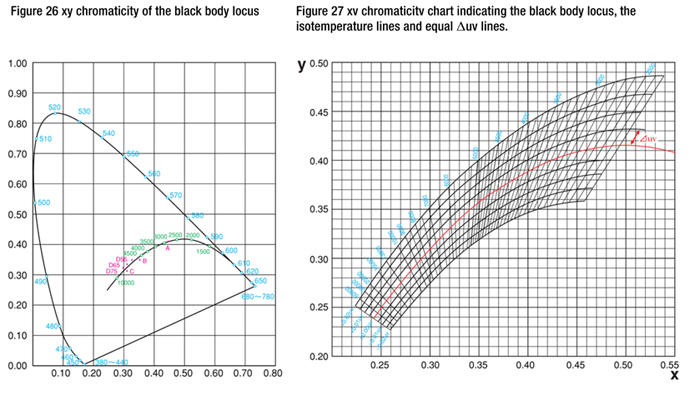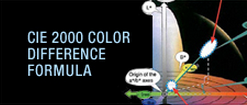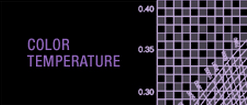Color Temperature
 As the temperature of an object increases, the emitted thermal radiation also increases. At the same time, the color changes from red through orange to white. A black body is an ideal object that absorbs all energy and emits it as radiant energy in such a manner so that its temperature is directly related to the color of the radiant energy given off. The absolute temperature of the black body is referred to as the color temperature. These colors would lie in the ideal black body locus, as indicated in the xy chromaticity chart shown in Figure 26.
As the temperature of an object increases, the emitted thermal radiation also increases. At the same time, the color changes from red through orange to white. A black body is an ideal object that absorbs all energy and emits it as radiant energy in such a manner so that its temperature is directly related to the color of the radiant energy given off. The absolute temperature of the black body is referred to as the color temperature. These colors would lie in the ideal black body locus, as indicated in the xy chromaticity chart shown in Figure 26.
Correlated color temperature is used to apply the general idea of color temperature to those colors that are close to, but not exactly, on the blackbody locus. The correlated color temperature is calculated by determining the isotemperature line on which the color of the light source is positioned. Isotemperature lines are straight lines for which all colors on the line appear visually equal; the correlated color temperature of any color on the isotemperature line is equal to the color temperature at the point where the iotemperature line intersects the blackbody locus.
The blackbody locus, the isotemperature lines and lines that indicate equal values of Δuv from the blackbody locus are illustrated in Figure 27. For example, a light source which has a color difference of 0.01 in the green direction (ΔEuv) from a black body which has a color temperature of 7000K is indicated as having a correlated color temperature of 7000K+0.0l (uv unit).
Notes
See Section IV “Color Terms” for explanation of (ΔEuv). “K” is an abbreviation for Kelvin. Kelvin is the absolute temperature scale







